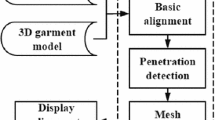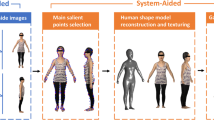Abstract
Personalized human shape plays an important role in system of virtual garment customization. In this paper, a new entity based multi-direction cooperative deformation algorithm (MDCD) is proposed to generate personalized human shape. We primarily extract the description parameters of entities using different direction sections based on unified division method. By introducing the entity curve interpolation and correspondence between elementary and target entities, the generated distortion of various human entities from simulated deformation function will be avoided. With the good capacity of accuracy and reusability of human entities, the MDCD algorithm can greatly improve the generation efficiency of personalized human shapes. The elementary entities on template model are firstly located using the division method of Poser, and description parameters on entities are then extracted based on the entity direction. Thus, shape characteristics can be represented by a set of direction curves on different angles by entity curve interpolation. Subsequently shape characteristics on personalized human body are generated by a comparison of direction curves of template and target entities. Finally, the MDCD algorithm is applied for generating personalized entities and shapes. Experiments show that compared with the existed algorithms, personalized human shapes generated by our method are smoother and more similar to the template model.














Similar content being viewed by others
References
Boisvert J, Shu C, Wuhrer S, Xi P (2013) Three-dimensional human shape inference from silhouettes: reconstruction and validation. Mach Vis Appl 24(1):145–157
Chaudhry E, You LH, Jin X, Yang XS, Zhang JJ (2013) Shape modeling for animated characters using ordinary differential equations. Comput Graph 37(6):638–644
Chen G, Li J, Zeng J, Wang B, Lu G (2016) Optimizing human model reconstruction from RGB-D images based on skin detection. Virtual Reality 20(3):159–172
Cui J, Liu Y, Xu Y, Zhao H, Zha H (2013) Tracking generic human motion via fusion of low- and high-dimensional approaches. IEEE Transactions on Systems, Human, and Cybernetics: Systems 43(4):996–1002
Domingo J, Ibanez MV, Simo A, Dura E, Ayala G, Alemany S (2014) Modeling of female human body shapes for appeal design based on cross mean sets. Expert Syst Appl 41(14):6224–6234
Dong Z, Jiang G, Wu Z, Cong H (2015) 3D parametric human modeling for warp-knitted seamless garment. Int J Cloth Sci Tech 27(4):532–548
Free 3D models database. http://artist-3d.com/free_3d.com/free_3d_models
Guo L, Dong R, Zhang M (2016) Effect of lumbar support on seating comfort predicted by a whole human body-seat model. Int J Ind Ergon 53:319–327
Han X, Wong KYK, Yu Y (2016) 3D human model reconstruction from sparse uncalibrated views. IEEE Comput Graph Appl 36(6):46–56
Hauswiesner S, Straka M, Reitmayr G (2013) Virtual try-on through image-based rendering. IEEE Trans Vis Comput Graph 19(9):1552–1565
Hosseini SJ, Araujo H (2016) From D-RGB-based reconstruction toward a mesh deformation model for monocular reconstruction of isometric surfaces. EURASIP Journal on Image and Video Processing. https://doi.org/10.1186/s13640-016-0114-9
Hsiao SW, Chen RQ (2013) A study of surface reconstruction for 3D mannequins based on feature curves. Comput Aided Des 45(11):1426–1441
Huang L, Yang R (2016) Automatic alignment for virtual fitting using 3D garment stretching and human body relocation. Vis Comput 32(6–8):705–715
Huang X, Hao K, Ding Y (2012) Human fringe skeleton extraction by an improved Hopfield neural network with direction features. Neurocomputing 87:99–110
Jang IY, Cho JH, Lee KH (2012) 3D human modeling from a single depth image dealing with self-occlusion. Multimedia Tools and Applications 58(1):267–288
Kocamaz MK, Rasmussen C (2015) Approaches for automatic low-dimensional human shape refinement with priors or generic cues using RGB-D data. Image Vis Comput 40:16–27
Koo BY, Park EJ, Choi DK, Kim JJ, Choi MH (2015) Example-based statistical framework for parametric modeling of human body shapes. Comput Ind 73:23–38
Kumara WGCW, Yen SH, Hsu HH, Shih TK, Chang WC, Togootogtokh E (2017) Real-time 3D human objects rendering based on multiple camera details. Multimed Tools Appl 76(9):11687–11713
Lee Y, Ma J, Choi S (2013) Automatic pose-independent 3D garment fitting. Comput Graph 37(7):911–922
Li K, Qian X (2015) Direct diffeomorphic reparameterization for correspondence optimization in statistical shape modeling. Comput Aided Des 64:33–54
Li J, Zhang M, Pan Z, Wang S, Yan Z (2015) Creating real body model of dressed human based on fat extent of body. Multimed Tools Appl 74(17):6951–6966
Liu Y, Cui J, Zhao H, Zha H (2012) Fusion of low-and high-dimensional approaches by trackers sampling for generic human motion tracking. In Proc. of the 21st international conference on pattern recognition 898–901
Liu Y, Nie L, Han L, Zhang L, Rosenblum DS (2015) Action2Activity: recognizing complex activities from sensor data. In Proc. of the 24th international conference on artificial intelligence 1617–1623
Liu L, Cheng L, Liu Y, Jia Y, Rosenblum DS (2016) Recognizing complex activities by a probabilistic interval-based model. In Proc. of the thirtieth AAAI conference on artificial intelligence 1266–1272
Liu Y, Nie L, Liu L, Rosenblum DS (2016) From action to activity: sensor-based activity recognition. Neurocomputing 181:108–115
Liu Y, Zhang L, Nie L, Yan Y, Rosenblum DS (2016) Fortune teller: predicting your career path. In Proc. of the thirtieth AAAI conference on artificial intelligence 83:201–207
Liu Y, Zheng Y, Liang Y, Liu S, Rosenblum DS (2016) Urban water quality prediction based on multi-task multi-view learning. In Proc. of the 25th international joint conference on artificial intelligence 2576–2582
Lu Y, Wei Y, Liu L, Zhong J, Sun L, Liu Y (2017) Towards unsupervised physical activity recognition using smartphone accelerometers. Multimed Tools Appl 76(8):1–19
Mao A, Zhang H, Liu Y, Zheng Y, Li G, Han G (2017) Easy and fast reconstruction of a 3D avatar with an RGB-D sensor. Sensors 17(5):1113
Nicholas M, Maria D, Andreas L (2017) Model-based generation of personalized full-body 3D avatars from uncalibrated multi-view photographs. Multimed Tools Appl 76(12):14169–14195
Orban GA (2011) The extraction of 3D shape in the visual system of human and nonhuman primates. Annu Rev Neurosci 34:361–388
Pickup D, Sun X, Rosin PL et al (2016) Shape retrieval of non-rigid 3D human models. Int J Comput Vis 120(2):169–193
Pishchulin L, Wuhrer S, Helten T, Theobalt C, Schiele B (2017) Building statistical shape spaces for 3D human modeling. Pattern Recogn 67:276–286
Preotiuc-Pietro D, Liu Y, Hopkins D, Ungar L (2017) Beyond binary labels: political ideology prediction of twitter users. In Proc. of the 55th annual meeting of the association for computational linguistics 1:729–740
Sabina O, Elena S, Emilia F, Adrian S (2014) Virtual fitting-innovative technology for customize clothing design. Procedia Engineering 69:555–564
Shen Z, Wang L, Zhao Y, Zhao Q, Zhao M (2014) GPU-based skin texture synthesis for digital human model. Biomed Mater Eng 24(6):2219–2227
Shi X, He S (2014) Modeling of 3D personalized digital apparel whole-human body based on mannequin components. Advances in Intelligent Systems and Computing 279:537–547
Soric J, Jarak T, Jalusic B, Hoster J (2015) Mixed meshless plate analysis using B-spline interpolation. TransFamena 39(1):1–14
Sun XY (2013) Three-dimensional line frame model design and realization of a human body for clothing. Adv Mater Res 753-755:1409–1415
Wu WC, Wang TH, Chiu CT (2015) Edge curve scaling and smoothing with cubic spline interpolation for image up-scaling. Signal Processing Systems 78(1):65–70
Wuhrer S, Pishchulin L, Brunton A, Shu C, Lang J (2014) Estimation of human body shape and posture under clothing. Comput Vis Image Underst 127:31–42
Yu Y, Zhou Y, Du S, Jie Y, Wang Z, Cai Z (2015) Learning human shape model from multiple databases with correspondence considering kinematic consensus. Vis Comput 31(1):19–33
Yuan M, Khan IR, Farbiz F, Yao S, Niswar A, Foo MH (2013) A mixed reality virtual clothes try-on system. IEEE TransMultimedia 15(8):1958–1968
Zhang M, Lin L, Pan Z, Xiang N (2015) Topology-independent 3D garment fitting for virtual clothing. Multimed Tools Appl 74(9):3137–3153
Acknowledgements
This work was supported in part by the National Science Foundation of China (No. 61703306), the Natural Science Foundation of Tianjin (No. 16JCQNJC00600), and the Doctoral Foundation of Tianjin Normal University (No. 52XB1302).
Author information
Authors and Affiliations
Corresponding author
Rights and permissions
About this article
Cite this article
Huang, X., Zhu, Y. An entity based multi-direction cooperative deformation algorithm for generating personalized human shape. Multimed Tools Appl 77, 24865–24889 (2018). https://doi.org/10.1007/s11042-018-5711-4
Received:
Revised:
Accepted:
Published:
Issue Date:
DOI: https://doi.org/10.1007/s11042-018-5711-4




